NDVI stands for "Normalized Difference Vegetation Index". NRG stands for "Near-infrared / Red / Green". NDVI and NRG are both ways to visualize the amounts of infrared and other wavelengths of light reflected from vegetation. Because both these methods compare ratios of blue and red light absorbed versus green and IR light reflected, they can be used to evaluate the health of vegetation. It's a snapshot of how much photosynthesis is happening. This is helpful in assessing vegetative health or stress. (Read more here: https://www.agronomy.org/publications/jeq/articles/36/3/832) ## Do-It-Yourself These techniques for vegetation analysis were developed for satellite imagery, but at Public Lab, we've been working a lot on capturing infrared imagery using our DIY [near-infrared camera](/wiki/near-infrared-camera) setup, and combining it with visible bands to produce NDVI images such as the one above. ## What these images mean What exactly are these images we're trying to make? What do they tell us about vegetation, and why? These diagrams should help to understand what it is we're doing and why these are good ways to analyze plant life. ## The NDVI equation [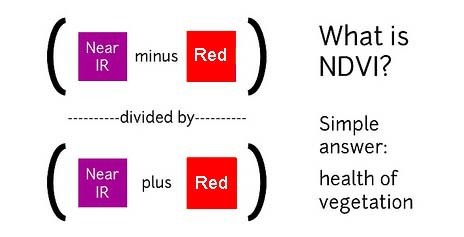](/i/44723) **NDVI = (Near Infrared - Red)/(Near Infrared + Red)** NDVI is a ratio which tries to emphasize photosynthesis while filtering out sun glare. The above equation is run for every pixel, using source data from an infrared photo and a visible light photo, like this pair: [](https://publiclab.org/system/images/photos/000/021/771/original/5390895115_c9d4d38fec_o.jpg) The result can be false-colored to make the high-photosynthesis areas more clear, and used to examine where plants are and how healthy they are. [](https://publiclab.org/system/images/photos/000/021/770/original/PetVISNDVIcomp.png) _Figure above: Normal color photo (right) and normalized difference vegetation index (NDVI) image (left). NDVI image was derived from two color channels in a single photo taken with a camera modified with a special infrared filter. Note that tree trunks, brown grass, and rocks have very low NDVI values because they are not photosynthetic. Healthy plants typically have NDVI values between 0.1 and 0.9. -- @cfastie_ ### Activities Here are a range of activities you can do to produce and interpret your own NDVI imagery, whether downloaded from a satellite imagery provider or [collected yourself using a DIY technique](/wiki/multispectral-imaging) [activities:ndvi] ****   Most DIY converted cameras today (those from Public Lab) use RGN instead of NRG, so the blue channel represents infrared instead of the red channel. That looks like this: [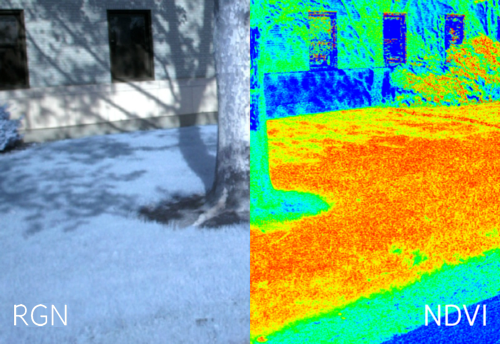](/i/45468?s=o) **** ## NRG imagery Some people are also interested in producing NRG imagery (like the below image), where `Near-Infrared, Red, and Green` are used to compose a picture instead of the usual `Red, Green, and Blue`. [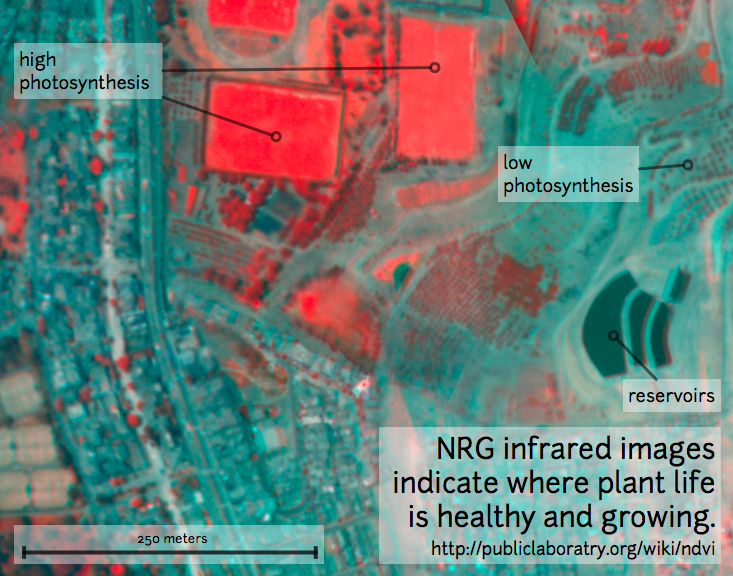](/i/25064) This diagram explains the swapping, which allows us to 'see' infrared as if it were a normal color: [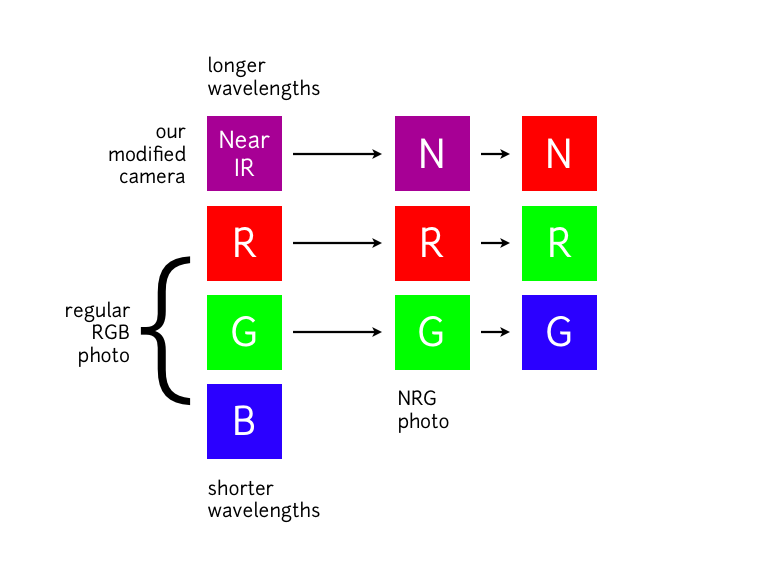](/i/25063) **In NRG images, the deeper and clearer the red color, the denser and healthier the vegetation (more or less).** ### Questions [questions:ndvi] ### Other examples of DIY NDVI imaging From around the internet: Begin watching at 2 minutes to see the resulting imagery: *This topic is part of the [Grassroots Mapping Curriculum](/wiki/mapping-curriculum) series.* **** [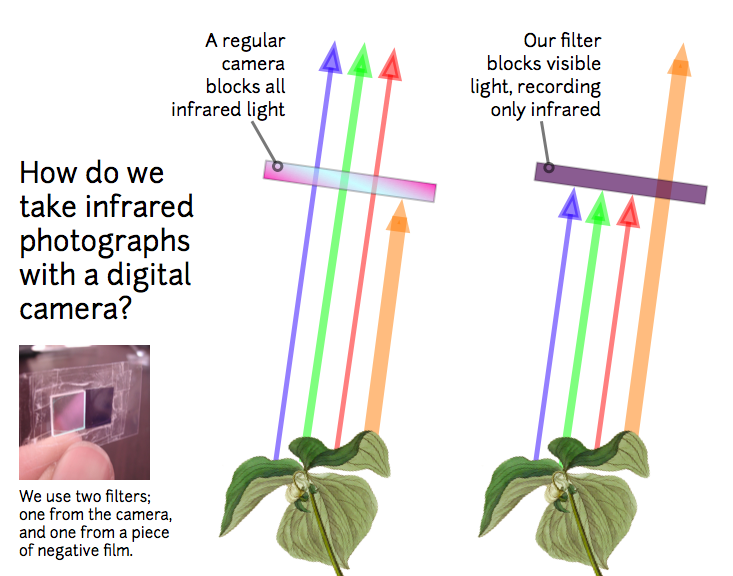](/i/25066) [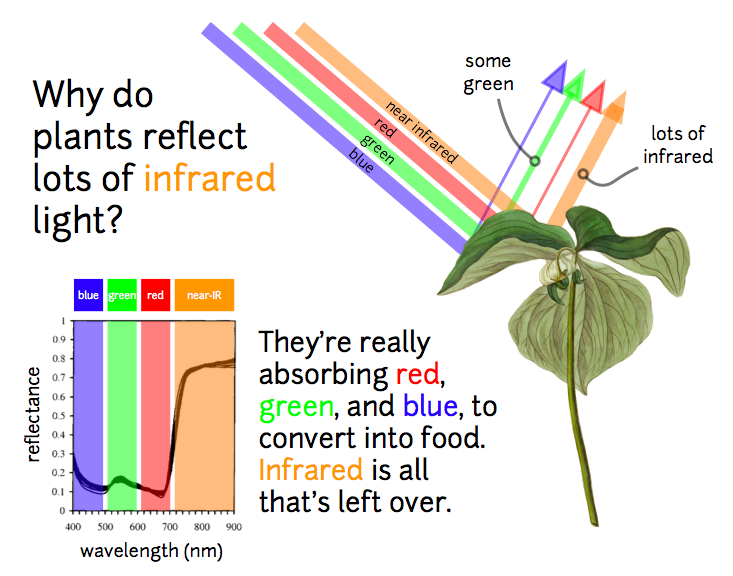](/i/25065) ...
| Author | Comment | Last activity | Moderation | ||
|---|---|---|---|---|---|
| Artichoke23 | "@Claytonb, This is a great post and comparison. I have a couple questions, I'm using the V2 NoIR Raspberry Pi camera and #2007 filter they provide ..." | Read more » | over 8 years ago | |||
| cfastie | "You can try other colors for doing a custom white balance. See this note: https://publiclab.org/notes/Claytonb/08-13-2016/plant-health-ndvi-white-b..." | Read more » | over 8 years ago | |||
| spandan1234 | "The NDVI map looks good. But is there anything that can be done to better the results. The information required is totally visible here. Any sugges..." | Read more » | over 8 years ago | |||
| cfastie | "Your photo looks good. An NDVI image made with the Photomonitoring plugin for Fiji also looks good. That might be a better way to process your phot..." | Read more » | over 8 years ago | |||
| spandan1234 | "Hi, I have taken some images directly from a Canon SX280 with a red filter. Then I calibrated it using the reflectance from red paper in the shade ..." | Read more » | over 8 years ago | |||
| nedhorning | "Hi - Using 440nm seem reasonable but I'd probably increase the NIR value to 760nm or beyond or something like that since the peak is probably beyon..." | Read more » | over 8 years ago | |||
| carolccarvalho | "Hello, @nedhorning, for the Rosco Roscolux #2007 Storaro Blue Gel Filter, with the following datasheet Could I just use the visible reflectance ..." | Read more » | over 8 years ago | |||
| cfastie | "This is a great discovery. It will be good to learn how this color works with a red filter like Wratten 25. I will keep my eye out for Boom Chicka ..." | Read more » | over 8 years ago | |||
| velorinaa | "Hello! I could have sworn I’ve been to this site before but after reading through some of the post I realized it’s new to me. Anyways, I’m definite..." | Read more » | over 8 years ago | |||
| velorinaa | "Thanks for sharing your information, its great and i appreciated about it! http://sbobetpoker.com | http://heropoker.net " | Read more » | over 8 years ago | |||
| YeongSeo | "Hi there The last post is over a year old so I don't know if there is anyone around to comment I'm really wondering that how can I overcome the Mi..." | Read more » | over 8 years ago | |||
| icarito | "Hi @warren I'm testing mail notifications anyway I'm interested in making NDVI photography soon. Pinging my alter ego too: @icarito_alter " | Read more » | over 8 years ago | |||
| cfastie | "The camera used to make that orthophoto image was a Canon PowerShot A590 from 2008. These are available on ebay for about US$30.00. It is a very g..." | Read more » | over 8 years ago | |||
| thechapu | "Thank you very much for your reply. You use that camera? That software used to calculate NDVI and make histogra " | Read more » | over 8 years ago | |||
| cfastie | "This is a great illustration that all of the standard white balance settings are very similar. The custom white balance setting used to produce pho..." | Read more » | over 8 years ago | |||
| thechapu | "Hello, If I removed the fitro for IR camera lens yesterday was a very sunny day in Santiago de Chile, take the occasion and take photographs chang..." | Read more » | over 8 years ago | |||
| cfastie | "Most surfaces reflect both NIR and visible light. Ideally you would have some targets that reflect various amounts of both and you would know the p..." | Read more » | over 8 years ago | |||
| cfastie | "Did you remove the camera's IR block filter before you installed the red filter? If so, the blue channel in your photos should be a good NIR photo..." | Read more » | over 8 years ago | |||
| carolccarvalho | "Hi Chris, thanks again! Which are the surfaces that reflect both blue and NIR light? Could you give me some examples? And about mobius camera, i ..." | Read more » | over 8 years ago | |||
| thechapu | " I reviewed my camera has 4 options for white balance, select the option 'sun' and these are the results " | Read more » | over 8 years ago | |||
| cfastie | "Yes sunlight is important. The light illuminating the plant should have about the same proportion of visible:NIR as sunlight or the results will be..." | Read more » | over 8 years ago | |||
| thechapu | "Hello cfastie, Thank you very much for your answer. I bought this pack of filters https://store.publiclab.org/collections/diy-infrared-photograph..." | Read more » | over 8 years ago | |||
| cfastie | "Cristofer, If you replaced the camera's IR block filter with a red filter (Rosco #19 or Wratten 25) The blue channel should capture mostly near in..." | Read more » | over 8 years ago | |||
| cfastie | "1) When you said shortcut, you meant I could for example use a blue led or a blue paint as target? Or do you have another suggestion? An LED or ot..." | Read more » | over 8 years ago |